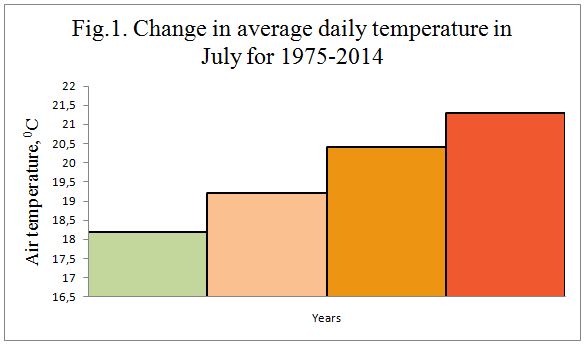
The average temperature in the month of July rose by 18,2°C to 21,3°C so that climate change in the direction of global warming occurs (Figure 1). In the afternoon, the temperature at the soil surface rises up to 50°C or higher.
Based on years of research and comprehensive analysis of the causes of severe weather phenomena can be seen that the person acting on the soil dramatically upset the balance of nature, the environment has changed the biocenosis. Monoculture grain – one of the reasons for the depletion of soils, and their destruction, development of water and wind erosion. There was a change of climate (droughts more often, even in places where they had been not seen previously), and in the end, all this affects the conditions of growth, development and productivity of plants. Every year, the impact on the environment increases and the society is not indifferent about what is the nature of this impact: natural-destructive, destructive to soil or consciously planned, aimed at expanded reproduction of soil fertility.
The hard work of tilling the land, collecting the crumbs of knowledge, passing from generation to generation through the experience of countless trials and errors, the man extended his knowledge of the soils, slowly but surely reveals the secrets of their fertility.
The practical, agricultural experience allows you to build and implement models of effective soil conservation farming systems.
Use, and even more rebuilding of the soil should be reasonably, carefully, based only on the knowledge of the laws of their formation, structure, composition and properties.
The biological type of agriculture is scientifically sound and promising. Soil regimes t and managemen of the process does not violate the natural biogeochemical environment and functions cultivated soils repeated natural.
Perennial legumes in the rotation increase the humus content and biological nitrogen in the soil, restore valuable lumpy granular structure, protect the soil from erosion, and ultimately create a cultural, fertile soil that could combat climate changes.
Along with this perennial grasses are addressed to solve the acute problem of forage protein and can create a strong fodder base for livestock, which in addition to its main task of provision the population with food – at the same time solves the problem of increasing soil fertility by increasing the output of manure which should be applied to the soil to create a deficit-free humus balance, but it needs to have a certain number of cattle.
Science and practice proved that one of the main conditions for continuous improvement of crop yields, livestock development and improvement of its productivity is correct and creative application of grassland farming system that makes it possible to increase the fertility of the soil in short term, to raise the culture of agriculture and on the basis of the year to year successful work to combat climate changes in the direction of global warming.
Author: SS Kostenko